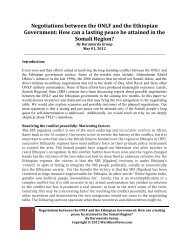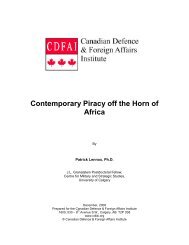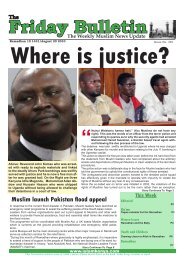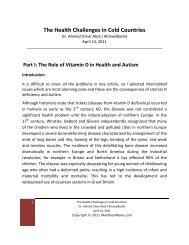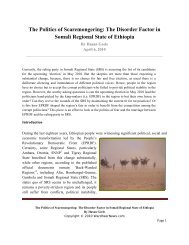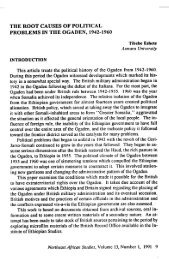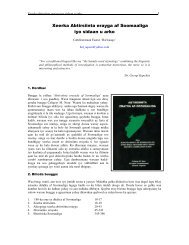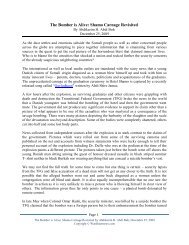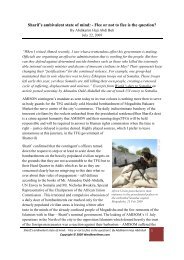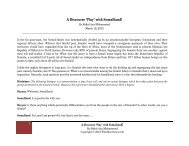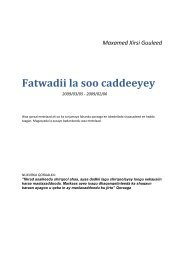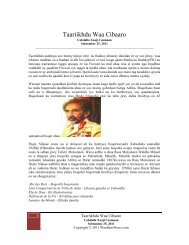View - WardheerNews
View - WardheerNews
View - WardheerNews
Create successful ePaper yourself
Turn your PDF publications into a flip-book with our unique Google optimized e-Paper software.
Resistance and coercion<br />
The most important group resisting EPRDF patronage is the ONLF, particularly its armed<br />
wing and followers in the bush. 32 Supported by Arab countries, Eritrea, Sudan, as well as<br />
followers in the worldwide Somali (Ogaden) Diaspora, the armed ONLF has increasingly<br />
radicalized since co-option of its more moderate wing into the regional government after<br />
1995. The front draws on broad popular support within the Ogadeni-inhabited zones of the<br />
region, where it actually controls movement of people and goods (UN-EUE 1995). The<br />
ONLF employs guerrilla tactics, and its fighters are deeply entrenched in the local pastoral<br />
communities. Large parts of the region are inaccessible for officials from the regional<br />
government who fear being targeted by the ONLF. The rebels are known to shoot<br />
highlanders as well as senior Somali-Ethiopian officials from the region, burn government<br />
vehicles, and beat up lower rank bureaucrats. Organized military rebellion by the ONLF<br />
not only threatens representatives of the Ethiopian state; it also divides the Ogadeni clans<br />
and families whose personal and kinship loyalties are increasingly torn between support for<br />
the front and the government. 33 The example of the mid-2004 murder of a kebele chairman<br />
in the Fiq district by his own brother (the latter being an ONLF activist) provides anecdotal<br />
evidence of this point. 34 Despite consistent rumours of secret negotiations between the<br />
Ethiopian national army and the ONLF, prospects for peaceful integration of the Ogadeni<br />
rebels into the political process as well as subsequent disarmament of fighters seems<br />
unlikely in the near future. The ONLF’s ultimate political objective seems to vary quite a<br />
bit through time. It is not always clear whether an independent state of ‘Ogadenia’, a<br />
Somali Region under Ogadeni rule, or a reunification with a future rebuilt Republic of<br />
Somalia constitutes its main agenda. Yet the front builds upon popular frustration among a<br />
large part of the Ogadeni population that feels oppressed by the highland military and<br />
perceives that it loses out on the spoils managed by the Jigjiga- and Addis Ababa-based<br />
political networks. In recent years, criticism of the ONLF has been voiced increasingly by<br />
Ogaden Somalis and by some of the rebels’ (former) supporters. The major bone of<br />
contention concerns the expediency of pursuing the armed struggle, or conversely, a<br />
political alternative. 35<br />
Pacifist opposition to neo-patrimonial rule increasingly stems from young male<br />
Somali-Ethiopians who graduated from the Ethiopian Civil Service College (ECSC) in<br />
Addis Ababa. Locally known as the ‘educators’ (sic) or ‘intellectuals’, they constitute a<br />
new group in regional politics. These ‘young Turks’ are among the few Somali-Ethiopians<br />
who received an opportunity to benefit from higher education. Most of them are urban-<br />
17



